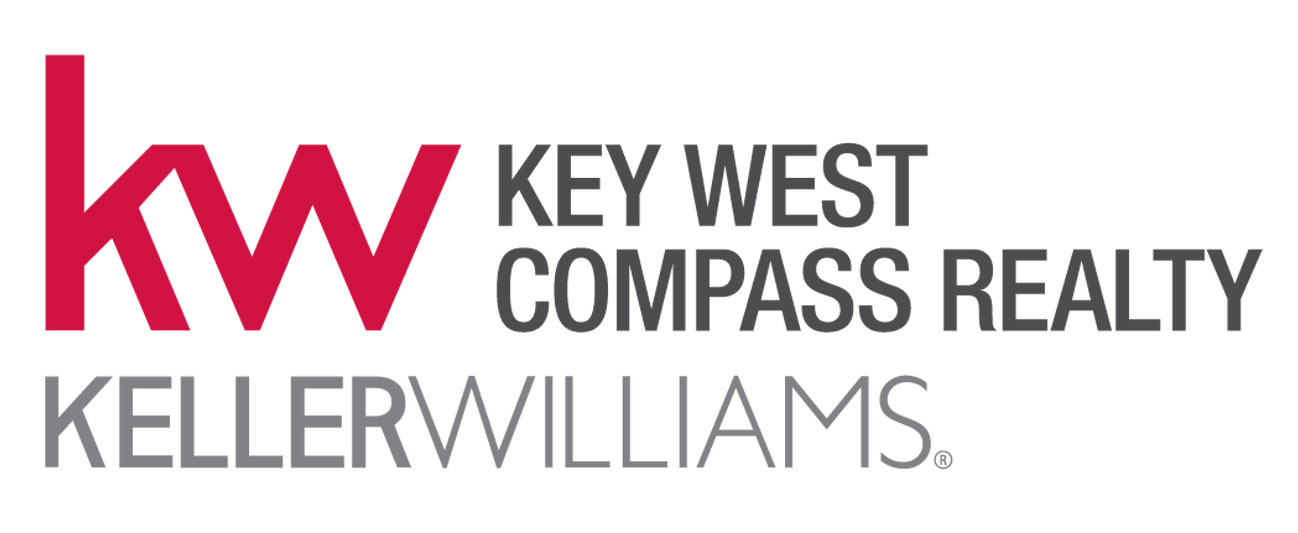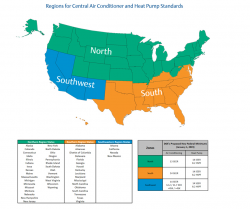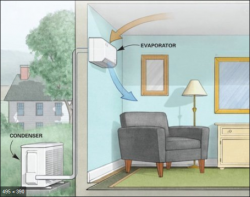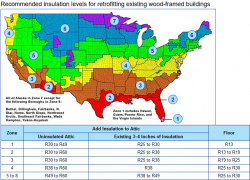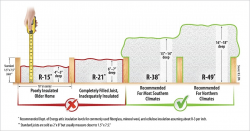Over one-third of my energy bill is consumed by central air conditioning - a split system with a 1.5 Ton 13 SEER unit for upstairs (bedrooms) and a 2.5 Ton 13 SEER unit for downstairs. Conservative temperature settings benefit from ceiling fans and Low-E Jeld-Wen windows and doors. At bedtime the downstairs A/C is shutdown and kept off until the next afternoon. Every Spring both systems are inspected, repaired and tuned-up as necessary. Even so, how can a Old Town Key West, frame constructed eyebrow, single family home circa 1925 use A/C more efficiently?
What is SEER?
Seasonal Energy Efficiency Rating (SEER) is a standardized ratio determined by dividing cooling capacity by the amount of electricity used to run the system. Beginning in January 2006, the lowest SEER rating for A/C units manufactured in the US is 13. The maximum SEER rating for central A/C units is 24. The higher the SEER rating the more efficient is the system.
SEER standards for air conditioners and heat pumps installed on or after January 1, 2015 differ by region. The previous 13 SEER standard for air conditioners installation improved to 14 SEER in most areas, but 13 SEER air conditioning units can still be installed in the northern regions.
Reminder - SEER is based on an a/c "matched" system. Changing only the condenser, for instance, does not quarantee all the efficiencies of a higher SEER rated system. There are six components to an a/c matched system:
- Thermostat
- Air Handler/Furnace
- Evaporator Coil
- Condensing Unit
- Ductwork
- Filters
How do I know which SEER is best for my house?
An a/c system should match the size and layout of the area to be cooled and the average temperatures and humidity for the location. A bigger system is not always best. Over capacity might cool the house more quickly, but the frequent on/off of the system increases wear and tear. Plus, while the temperature setting might be satisfied, rapid cooling often does not eliminate the humidity in the house resulting in clammy air. And we all know what damp air can do inside a house, Key West or otherwise.
An air conditioner’s capacity is measured in tons; that is, how much heat a unit can remove in an hour. Square footage of your space, windows, ceiling height and climate determine the size, in tons, for your a/c. In South Florida and Key West a/c systems that are 1.5 tons can cool a 600 - 900 sqft space, 2 tons can cool 900-1200 sqft, 2.5 tons can cool 1200-1500 sqft, etc.
Suppose I wanted to replace my downstairs 2.5 ton 13 SEER system.
Using this Energy Saving Calculator, if I upgraded from a 2.5 ton, 13 SEER to a 2.5 ton 19 SEER, I would experience an approximate 43% cost savings per year resulting in a 10 year savings of approximately $2850. This is based on $.11 per KWh. Keys Energy in Key West charges $.13 per KWh. This second calculator allows you to adjust the cost per KWh (at the very bottom left of the page). Adjusting to $.13 per KWh results in an estimated 10 year cost savings of $4320 for the same upgrade.
Is a ductless system a better choice?
But hey, I just want to cool my reclaimed attic, pool house or mother-in-law suite/man cave/dog house. How about one of those small ductless mini-splits?
Ductless a/c systems operate with the same SEER ratings as central a/c systems but, instead of tons of output, ductless systems use BTU's - British Thermal Units. A BTU is the amount of energy needed to cool one pound of water by one degree Fahrenheit; hence 9000 BTU's, 12000 BTU's, 24000 BTU's, etc.
In Florida, and other routinely hot regions, a guide is to use 30 BTu's per square foot as a base. Use lesser BTU's for shaded and insulated rooms, more BTU's if not. (500 sqft x 30 BTUs equals a 15,000 BTU unit). Often times, multiple indoor cooling units (evaporators) can be connected to a single outdoor condenser. Also, when shopping for mini-splits, look for humidity detection sensors, automatic timers and of course very low noise.
When is enough insulation enough?
Insulation is probably the cheapest and least hassle installation strategy for optimizing cooling (or heating) in your home. Insulation is rated by R-Value. R-Value indicates how well the material resists heat transference; the higher the R-Value the better the effectiveness. R-Value depends on:
- Type of insulation
- Thickness
- Density
- Installation. Note: Compressed insulation will not provide its full R-Value (Compressed is different from Rigid insulation)
- Gaps caused by installation or shrinkage lowers the effective R-Value
- Moisture significantly lowers R-Value effectiveness
The easiest and most cost effective place to install insulation, especailly in an old wood frame conch house, is the attic. The most common types of residential attic insulation are fiberglass batts and cellulose loose-fill. Batts of fiberglass are spun fiberglass fibers pre-cut to roll out between ceiling joists. That pink stuff.
Show me the money (saved)
Fiberglass batts have an R-value of 3.1 per inch. As you can see by the graphic, insulation in Florida should be R-30 to R-49. R-30 is almost 10 inches thick (30/3.1), R-49 is about 16 inches (49/3.1). The Insulation Institute recommends 13" to 14" of attic insulation for southern states. R-30 batts are manufactured to be almost 10 inches thick. In an attic, the first layer of a fiberglass should be placed between the joists. Any second layer should be placed perpendicular to the first.
For additional details on insulating cathedralized ceilings, walls, crawl spaces, ventalization, mositure control, etc., read this Energy Star report.
And so, will any of this; higher rated SEER air conditioning, R-30+ insulation, material and labor, pay for itself? In truth - not likely. By the time these energy upgrades have actually paid for themselves through the multi-year sum of reduced energy bills, it will probably be time to re-upgrade. So - why bother?
Conclusion
If you have any plans to sell your home within 1 - 3 years after upgrading the energy efficiency of your home, you will definitely stand ahead of the crowd. Energy savings and the GREEN home ownership movement is very strong, especially among buyers in the 35 - 55 year old age group.
Multiple Listing Services (MLS), including the Key West Association of Realtors MLS, have specific fields to be filled out by the Listing Agent when the property is listed for sale. These fields identify energy related elements and ratings. As a GREEN Designated Realtor by the National Association of Realtors (NAR), I can assure you, your effort to upgrade the energy status of your Key West home would be a key component of every facet of my marketing and pricing campaigns to Sell your home.
On the other hand, if you are not going anywhere and you are upgrading the energy efficiency of your home for your own benefit, then know you are making wise investment and energy conservation choices for your family and your home, the result of which will be a cleaner, quieter and more comfortable lifestyle. Well Done.
Please also read, The Cost of GREEN - Part 1 - Residential Solar.
If you have any comments or questions, please contact me here.
Good luck!
Additional Resources:




